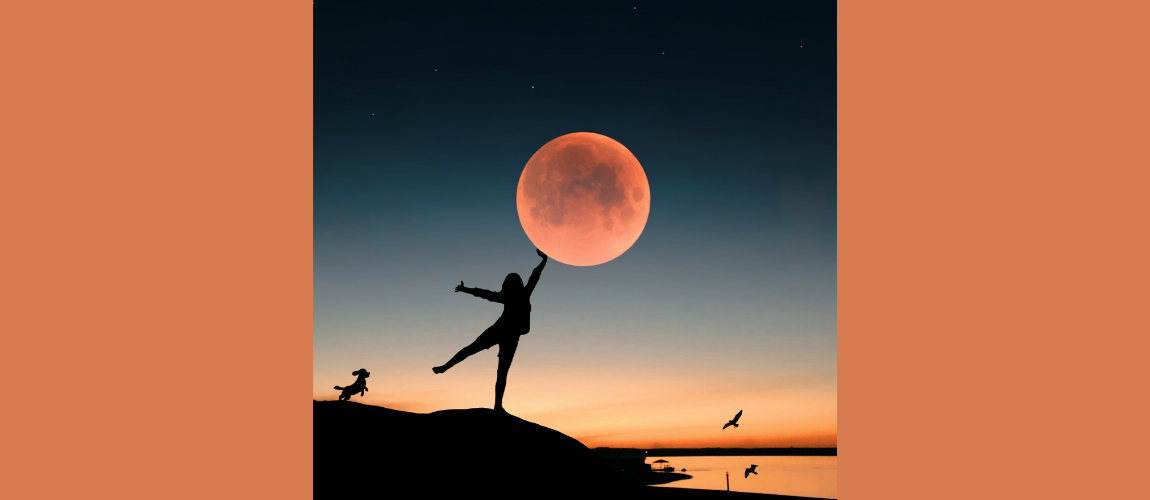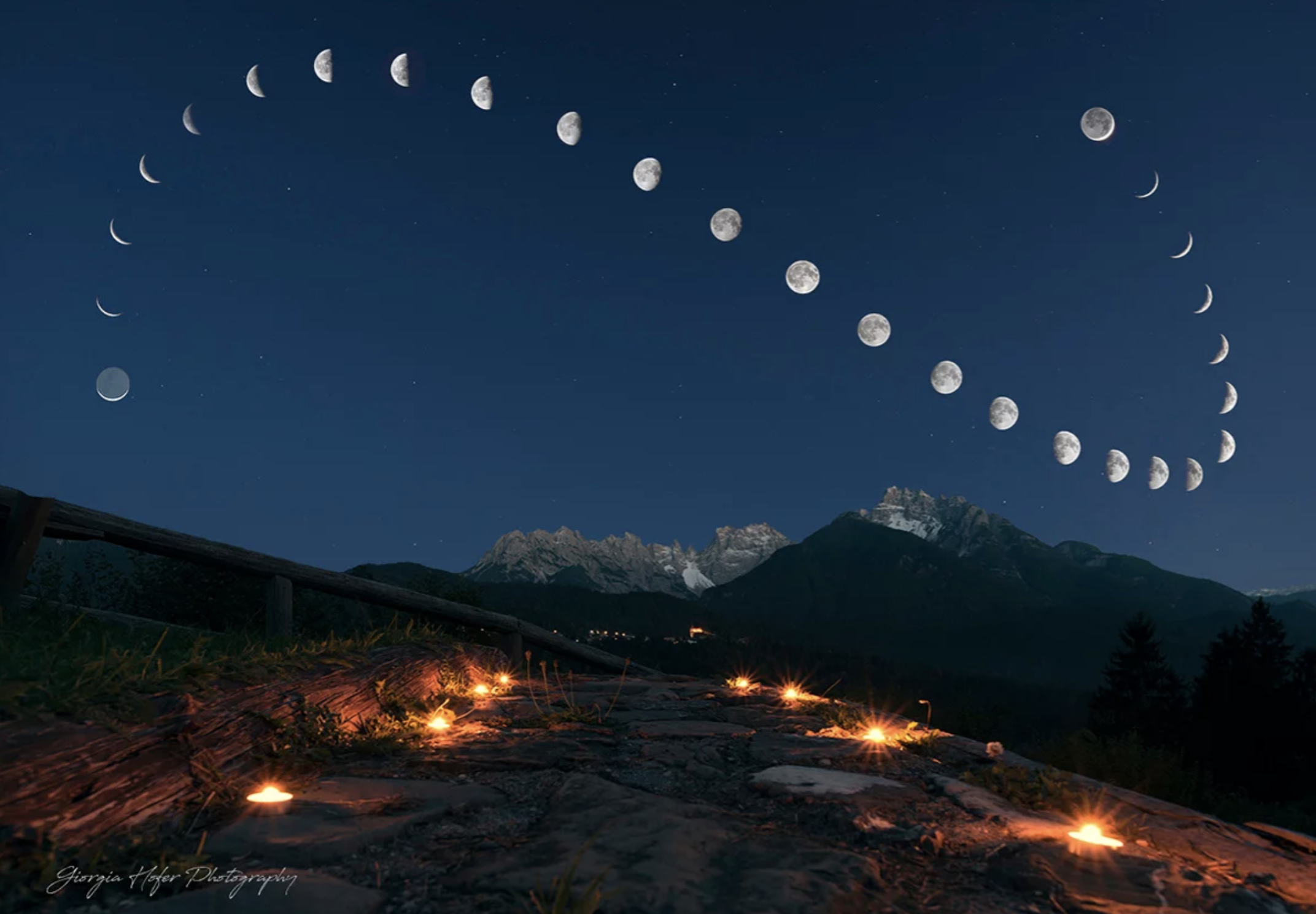Whenever the moon is full, it’s a monthly invitation to slow down, look up and really connect to the wonder of that glowing rock in space. The full moon this Wednesday (May 26) will be something extra special to behold, as the only total lunar eclipse of 2021 arrives together with the year's second "supermoon." Read on for more about how to enjoy this special May moon.
Supermoon—A moon becomes a supermoon when it is full and near or at the closest point in its elliptical orbit around the earth. Because it is so close to us, it can appear up to 14% bigger and up to 30% brighter than the typical full moon. This is the second and the biggest of the three "supermoons" we'll have in 2021, and it will likely be the most spectacular!
Blood moon—This particular moon may also temporarily appear blood red in they sky as it passes through the Earth's shadow. That is why we call total lunar eclipse moons "blood moons."
How to watch the eclipse—Though we'll be able to see the full moon everywhere not covered in clouds, not everyone will be able to see the lunar eclipse in action, including here in the Eastern third of the US. For those who can catch it, you'll need to catch it in the week hours. Here are the times at which you can see the eclipse in action, thanks to https://astronomy.com/news/observing/2021/05/how-to-view-the-super-flower-blood-moon-on-may-26:
- Partial eclipse begins: 2:45 A.M. PDT/5:45 A.M. EDT
- Total eclipse begins: 4:11 A.M. PDT/7:11 A.M. EDT
- Total eclipse ends: 4:26 A.M. PDT/7:26 A.M. EDT
- Partial eclipse ends: 5:52 A.M. PDT/8:52 A.M. EDT
For those of us where the eclipse isn't visible — or where clouds spoil the view — you can still watch via several free webcasts showing live views of the eclipse online. For example, weather permitting, the Griffith Observatory in Los Angeles plans to stream live views of the Super Flower Blood Moon on Wednesday (May 26) beginning at 4:45 a.m. EDT as the first phase of the lunar eclipse begins and end at 9 a.m. EDT. You can visit space.com to learn even more about this special moon, the eclipse and other ways to watch online.
So, in celebration the full moon tonight, here are 10 great ways you can fall even more in love with this special May moon:
1: Celebrate the Full Moon Rise!
If you can catch the moon at its rise above the horizon, you will see it at its largest. This happens right around when the sun sets and, in April, is still a good timing for even small kiddos (around 8pm in my Western MA location)! You can enter your zip code on the Farmer's Almanac site to find the moon rise and set times in your area. Though not yet fully illuminated (that takes several hours more).
Each month, the full moon appears on the eastern horizon in twilight, and the moon looks really large, giving it even more impact. So if you can plan for it, and your kids can handle it when the moonrise gets later, make it a family tradition to catch that magic moonrise moment.
So far this year, we have driven up a hill to catch the moonrise, then had friends over, made a fire and just enjoyed hanging out under the full moon. Being out at night in such bright moonlight is truly magical for kids—and adults!
2: Catch the Moon During the Day.
If the moonrise happens too far past bedtime or you miss it, make it a habit to wait a few days and try to catch a glimpse of the still-big moon in daylight! For little kids, this may be the best way to see the moon, especially in the summer months.
The night right after “full moon night,” the moon rises in the east about 50 minutes after sunset and sets 50 minutes after sunrise the following morning. And, this 50 minute shift happens every day to follow. So, the moon starts to hang out in the sky during the day time—that’s why you see the moon pop up sometimes in the bright blue sky.
3: Learn How the Moon Reflects Nature.
Throughout time, various peoples indigenous to North America and different cultures around the world have assigned the various full moons special names. For example, the Obijwe people of the Great Lakes refer to the moon as the "blossom moon" (waabigwani-giizis) for all of the flowers in bloom this time of year, while the Cherokee people called it the planting moon (ansgvti). All of these names tend to correspond with what is happening on the ground as the particular full moon occurs.
Learning about these names attunes us to what is happening in nature. You can find the names of moons in many places, but I like this list for the range of cultures it includes.
In our family, we've started talking about how each moon was named, which helps us all notice the various things happening around us here in New England. The kids noticed that, though there were some flowers blooming for last month's "pink" moon, there are so many more flowers in our flower beds and on the trees. We've also noticed how the air is thick with the scent of all of these blossoms with this full moon.
To celebrate this moon, go on a noticing walk with kids and find signs of flowers in bloom popping out in your yard, neighborhood or local park. Welcome older kids to build a photo slideshow or create art to capture what they are noticing outside, too.
4: Get Inspired.
Back in time for March’s “worm moon,” I had the pleasure of talking with Nicolette Sowder, creator of Wilder Child and the Kids’ Moon Club and marvelous human, as part of our weekly Tinker Talk series. Enjoy listening to 15 minutes of Nicolette’s moon-loving wisdom in the video!
5: Start Something New!
A new moon is a great time to start fresh or kick off something new. Plus, we are starting to see hope for post-pandemic life, and it seems as if the whole world has. started the process of waking up. So, use this weekend to let go of something that is burdening you or to take an idea or practice you've wanted to start and give it a go! This includes planting new seeds. Gardeners and farmers have been following the moon cycle for thousands of years, knowing that the moon's pull helps water in the soil better reach new seeds and seedlings during a full moon—amazing!
6: Just Start to Notice the Cycle.
Even if you don’t notice it every day, make a habit to check in on the moon throughout the next month. Notice how it changes, when it’s in the sky during the daylight and what shape it takes at night. Our free monthly activity calendars include an image of which phase the moon is in each day to help you keep track. And you can find out when the moon will rise, set and be in the daytime sky here.
You can also think of it as simply welcoming the moon into your life in a more meaningful way. Nicolette advises, "When you are first greeting the cycle and getting comfortable with it, just do the welcoming and the emotive piece and root yourself inside of the cycle—don't feel like you need to rush into any activities.” We've started with simply making time for the moon and trying to notice it throughout each cycle.
—photgraph by Giorgia Hefer
7: Discover How the Moon Organizes Life.
It never really crossed my mind that the word month comes from words for “moon.” The very way we mark time and organize our lives comes from the moon and its cycles. In a way, we’re all already moving with the moon!
Many of us know that the moon’s gravitational pull is what drives the ocean tides, but it’s still pretty mind blowing. Did you know that for centuries people have used the moon and its phases to guide when they plant and how they care for the seeds they sow?! For example, it's a great time to plant seeds during the full or new moons.
8: Learn Some Cool Moon Facts!
- There is a new full moon every 27 days or so, and it happens when the Earth is positioned almost right between the sun and the moon. That’s why the moon is fully illuminated (Earth rarely gets exactly between the two. When it does, it’s a lunar eclipse). Because the moon is aligned with the sun, a full moon rises right around sunset, shines all night long, and then "sets" when the sun rises again the next morning.
- Did you know the moon is a quarter the size of the earth? And that on its surface are seas filled with hardened lava?
- The moon doesn’t produce its own light; what we see is the sun reflected off of it.
- The moon is not actually a perfect sphere. Instead, it's shaped like an egg. When we look up at the moon from Earth, one of the small ends is pointing right at us, so it appears round to us.
- At roughly one-fourth the diameter of Earth, some scientists think the moon is more like a planet. They refer to the Earth-moon together as a "double planet."
- For more facts, visit National Geographic Kids or, for some real-time data and cool images, check out Nasa’s moon landing page.
9: Take the Moon for a Walk.
It’s a Tinkergarten DIY activity, a beloved book and a super fun way to help kids notice how the moon follows us wherever we go! Try our activity; it’s both thrilling and calming under any moon, at any age.
10: Read Books about the Moon.
Our team has compiled a list of our 13 favorite moon books. Read some of these to spark curiosity and tune even more into the magic of the moon!


